Amphitheatre › Hecate » Ancient origins
Articles and Definitions › Contents
- Amphitheatre › Antique Origins
- Hecate › Who Was
Ancient civilizations › Historical and archaeological sites
Amphitheatre › Antique Origins
Definition and Origins

An amphitheatre was a structure built throughout the Roman empire where ordinary people could watch such spectacles as gladiator games, mock naval battles, wild animal hunts, and public executions. Usually oval in form, the largest examples could seat tens of thousands of people, and they became a focal point of Roman society and the lucrative entertainment business. Amphitheatres are one of the best surviving examples of ancient Roman architecture, and many are still in use today, hosting events ranging from gladiator re-enactments to opera concerts.
ARCHITECTURAL FEATURES
The fully enclosed amphitheatre was a particular favourite of the Romans and evolved from the two-sided stadiums and semicircular theatres of ancient Greece. The date and location of the first true amphitheatre are unknown, but the tradition of gladiator fights had roots in the Etruscan and Osco-Samnite cultures. The earliest securely dated amphitheatre is that of Pompeii, built c. 75 BCE and known as the spectacula. Early structures took advantage of rock and earth hillsides to build the banks of wooden seating on, but by the 1st century BCE free-standing stone versions were being constructed.Amphitheatres of all sizes were built across the empire as Roman culture swept in the path of its army. Indeed, army camps often had their own dedicated arena, usually built using timber and used for training as well as entertainments. Amphitheatres were made oval or elliptical so that the action would not remain stuck in one corner and to offer a good view from any seat in the house.
The Colosseum, officially opened in 80 CE and known to the Romans as the Flavian Amphitheatre, is the largest and most famous example with a capacity of at least 50,000 spectators. Dwarfing all other buildings in the city, it was 45 metres high and measured 189 x 156 metres across. It had up to 80 entrances, and the sanded arena itself measured a massive 87.5 m by 54.8 m. On the upper storey platform, sailors were employed to manage the large awning ( velarium ) which protected the spectators from rain or provided shade on hot days.
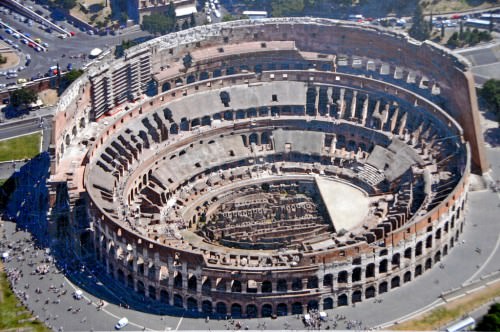
The Colosseum or Flavian Amphitheatre
The Colosseum's design became famous as it was placed on coins so that even people who had never been in person knew of Rome 's greatest temple to entertainment. The design was copied throughout the empire: a highly decorative exterior, multiple entrances, seating ( cavea ) set over a network of barrel vaults, a wall protecting spectators from the action of the arena (sometimes with nets added), and underground rooms below the arena floor to hide people, animals, and props until they were needed in the spectacles. There was also an extensive drainage system, a feature seen at other arenas such as Verona 's amphitheatre where it still functions and has greatly contributed to the excellent preservation of the monument.
The Arena of Verona measures 152 x 123 metres and was third biggest after the Colosseum and Capua. It is another excellent example of the features involved in a Roman amphitheatre. It was constructed in the 1st century CE, using a cement and rubble mix known as opus caementicum, brick, and stone blocks set in square pillars to create an external façade of three levels of 72 arches, each spanning 2 metres and creating a total height of over 30 metres. The lowest arches lead directly to an interior corridor 4.4 metres wide, which runs around the Arena. From this corridor, steps lead upwards at regular intervals and on four different levels to form vomitoria (exits), which give access to the interior cavea. Inside, the seats were arranged in four elliptic rings giving a total of 44 rows of seating.
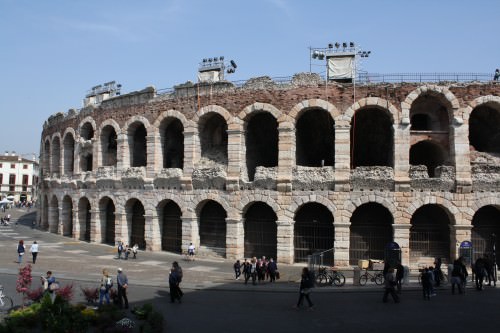
Amphitheatre of Verona
The Romans built over 200 amphitheatres across the empire, most of them in the west as in the east very often existing Greektheatres and stadiums were converted/employed for public spectacles. Other well-preserved arenas besides the Colosseum and the Arena of Verona which can be visited today include Arles, Burnum, Capua, El Djem, Frejus, Nimes, Leptis Magna, Pergamon, Pompeii, Pula, Salona, Tarragona, and Uthina.
IF THERE WAS ONE THING THE ROMAN PEOPLE LOVED IT WAS SPECTACLE & THE CHANCE TO SEE THE WEIRD & WONDERFUL SHOWS WHICH ASSAULTED THE SENSES & RATCHETED UP THE EMOTIONS.
THE EVENTS
If there was one thing the Roman people loved it was spectacle and the chance to escape reality for a few hours and gawk at the weird and wonderful public shows which assaulted the senses and ratcheted up the emotions. Roman rulers knew this well, and so to increase their popularity and prestige with the people, they put on lavish and truly spectacular shows, which cost fortunes and lasted all day for several days. The whole live entertainment industry thus became a huge source of employment, from horse trainers to animal trappers, musicians to sand rakers.
To modern eyes, the bloody spectacles put on by the Romans can cause revulsion, but perhaps we should consider that the sometimes shocking events of these spectacles were a form of escapism, just as cinema and computer games are today, rather than representative of social norms and barometers of accepted behaviour in the Roman world. Perhaps the shockingly different world of Roman spectacle, in fact, helped reinforce social norms rather than acted as a subversion of them.
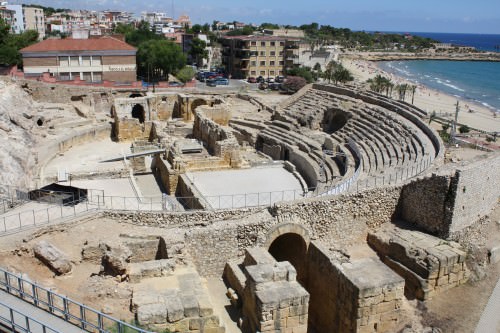
Tarraco Amphitheatre
Emperor Augustus established rules so that slaves and free persons, children and adults, rich and poor, soldiers and civilians, single and married men were all seated separately, as were men from women. Naturally, the front row with more comfortable seats in amphitheatres was reserved for the local senatorial class. Tickets were probably free to most forms of spectacle, as organisers, whether city magistrates given the responsibility of providing public civic events, super-rich citizens, or the emperors who would later monopolise control of spectacles, were all keen to display their generosity rather than use the events as a source of revenue.
Gladiator Fights
In the bloody events of the arena, none came more graphic than the one-on-one gladiator fights. Qualities such as courage, fear, technical skill, celebrity, and, of course, life and death itself, engaged audiences like no other entertainment, and no doubt one of the great appeals of gladiator events, as with modern professional sport, was the potential for upsets and underdogs to win the day.
In Rome, city magistrates had to put on a gladiator show ( munera ) as the price for winning office, and cities across the empire offered to host local contests to show their solidarity with the ways of Rome and to celebrate notable events such as an imperial visit or an emperor's birthday. Gladiator fights became hugely popular, and those who went on a winning streak became living legends, darlings of the crowds who even had their own fan clubs.
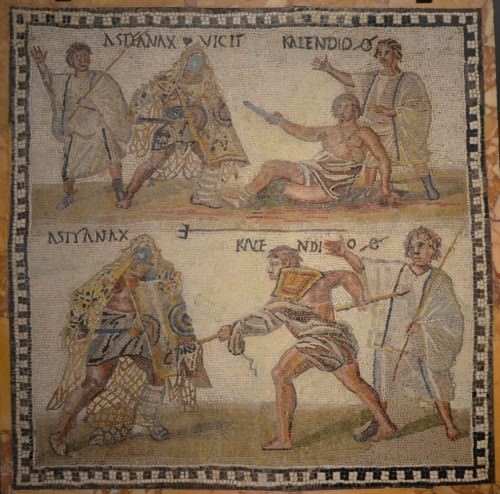
Gladiator mosaic
Wild Animal Hunts
Besides gladiator contests, Roman arenas hosted events using exotic animals ( venationes ) captured from far-flung parts of the empire such as rhinos, panthers, and giraffes. These were made to fight each other or humans. Animals were frequently chained together, often a duo of carnivore and herbivore, and cajoled into fighting each other by the animal handlers ( bestiarii). Certain animals acquired names and gained fame in their own right as did their human 'hunters' ( venatores ). During these events, the underground mechanisms were employed to have animals appear unexpectedly in the arena, which was often landscaped with rocks and trees to resemble exotic locations and heighten the realism.
Mock Naval Battles
Shows in the arena often accompanied the lavish festivities held during a Roman triumph, and one of the most popular events was to audaciously restage real naval battles ( naumachiae ), naturally, in as lifelike and deadly fashion as possible.Julius Caesar commemorated the Alexandrian war by staging a huge battle between Egyptian and Phoenician ships while Augustus staged one to celebrate his victory over Mark Anthony at Actium. Nero went one better and flooded an entire amphitheatre to host his naval battle show. These events became so popular the later emperors did not need the excuse of a military victory to wow the public with epic mythologically-themed sea battles. The manoeuvres and choreography of these events were invented but the fighting was real, and so condemned prisoners and prisoners of war gave their lives to achieve ultimate realism for the baying crowd.

Fresco Amphitheatre, Pompeii
Public Executions
Arenas also hosted the execution of criminals – usually during the lunchtime lull – which was achieved in imaginatively gruesome ways like setting wild animals on the condemned ( damnatio ad bestias ) or making them fight well-armed and well-trained gladiators or even each other. Other more theatrical methods included burning at the stake or crucifixion, often with the prisoner dressed up as a character from mythology to give a little extra colour to the occasion. The spectators were not passive viewers as sometimes an execution was cancelled if the crowd demanded it.
DECLINE & REUSE
Eventually, gladiator contests, at odds with the new Christian-minded Empire, declined under the later emperors and finally came to an end in 404 CE. The spectacle of criminals fighting animals went on for another century, but gradually the amphitheatres crumbled into disuse and suffered varying degrees of reuse and abuse. The tale of the Colosseum is a common fate: made into a fortress in the 12th century CE, damaged by an earthquake in the 13th century CE, and used as a public quarry by Pope Alexander VI. Still, the Colosseum and many other surviving Roman arenas remain today magnificent monuments and enduring testimony to both the skills and the vices of the Roman world. Many amphitheatres are actually still in use and still host large crowds for all manner of cultural events such as the world-famous summer opera season in Verona, mock gladiator fights in Tarragona, and rock concerts at Arles.
Hecate › Who Was
Definition and Origins
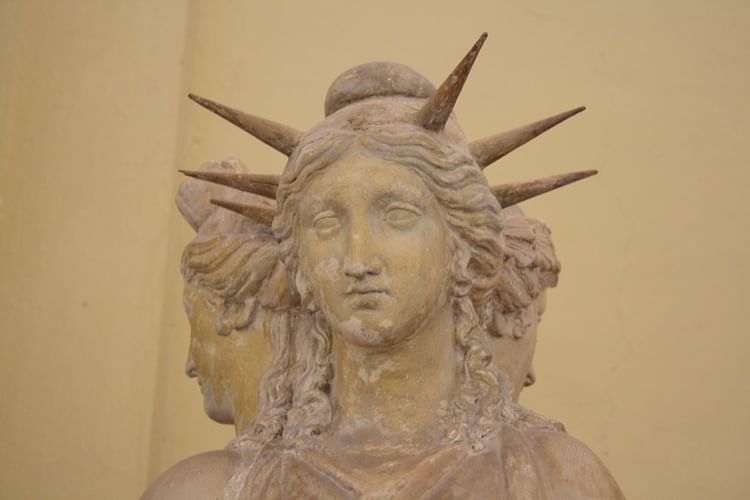
Hecate (Hekate) is a goddess of Greek mythology who was capable of both good and evil. She was especially associated with witchcraft, magic, the Moon, doorways, and creatures of the night such as hell-hounds and ghosts. She is often depicted carrying a torch to remind of her connection with the night and in sculpture with three faces, representing her role as the guardian of crossroads.
GENEALOGY
According to Hesiod in his Theogony, Hecate is the daughter of Perses and Asteria, making her the granddaughter of the Titans Phoebe and Coeus. Euripides, on the other hand, mentions her mother is Leto. Other writers claim her as the daughter of Zeus and Demeter, Aristaion or Night. The goddess was frequently associated with Demeter and even assimilated to her in some cults.
ASSOCIATIONS & RITUALS
From the 5th century BCE, the goddess is associated with the darker side of the human experience, that is death, witchcraft, magic, the Moon, dreams, fierce hounds and creatures which roam the darkness of night. As the Oxford Classical Dictionary phrases it,
…outlandish in her infernal aspects, she is more at home on the fringes than in the centre of Greek polytheism.Intrinsically ambivalent and polymorphous, she straddles conventional boundaries and eludes definition. (649)
Hesiod describes the goddess in the following glowing terms:
Zeus, Cronus' son, honoured [Hecate] above all others: he gave her splendid gifts - to have a share of the earth and of the barren sea, and from the starry sky as well she has a share in honour, and is honoured most of all by the immortal gods. For even now, whenever any human on the earth seeks propitiation by performing fine sacrifices according to custom, he invokes Hecate; and much honor very easily stays with that man whose prayers the goddess accepts with gladness, and she bestows happiness upon him. (Theogony 411-420)
Hesiod goes on to say that the goddess supports warriors, athletes, hunters, horsemen, herdsmen, shepherds, fishermen, and children. Her companions are the Furies (Erinyes), the winged creatures who punished wrong-doing, and her children are the Empusae, female demons partial to seducing travellers.
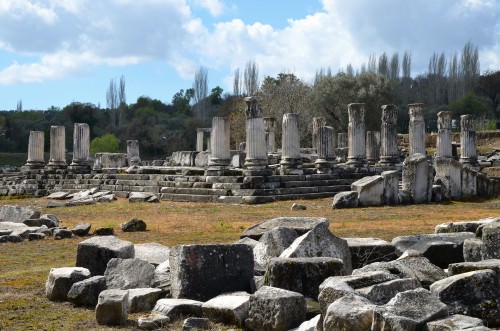
The Temple of Hecate in Lagina, Caria
The goddess had unusual rituals performed in her honour, which include the offerings of food - given at crossroads, road junctions, and any other sort of boundary or threshold - known as 'the supper of Hecate'. These took the form of small cakes of eggs, cheese, bread, and dog meat, which were lit with miniature torches or, alternatively, a dish of red mullet, which was usually prohibited from offerings to the other gods. Hecate was also offered the sacrifice of dogs, especially puppies. The dog connection may be the fact that dogs were known to eat the dead if left unburied; they also howl at the moon, of course. A further canine connection may be with the Egyptian god Anubis who guided souls to the underworld, and the Greek three-headed hound of Hades, Cerberus, may be an earlier form of Hecate. The offerings to the goddess were made each month during the night of a new moon. The goddess was especially appealed to by sorceresses for aid in their magic and spells and appears on surviving examples of curse tablets.
IT WAS A COMMON PRACTICE TO PLACE IMAGES OF HECATE AT CITY GATES & THE DOORWAYS OF PRIVATE HOMES AS SHE COULD WARD OFF EVIL SPIRITS.
According to Pausanias, the 2nd-century CE Greek traveller, the island of Aegina had a mystery cult dedicated to the goddess where it was believed those suffering mental illness could be cured. Kos, Erythrai, Samothrace, Thessaly, and Miletos also worshipped the goddess, with the latter having a 6th-century BCE circular altar for sacrifices to be made in her honour (the earliest archaeological evidence of her worship). The worship of Hecate continued into the Hellenistic and Roman periods with significant archaeological finds of votive offerings to the goddess being found at Lagina in Caria and Phrygia.
HECATE IN ART
Hecate appears regularly in Greek art and literature only from the 5th century BCE onwards, before which she is only a minor figure who features in the stories of Demeter (as Persephone ’s handmaid) and Artemis. This may indicate the goddess' relatively late arrival in Greece from Caria, although, she was considered a Greek goddess and not of foreign origin by the ancient Greeks themselves. She is typically portrayed on Greek pottery as a young woman carrying a torch or a key, both reminders of her function as a night deity and a guardian of the gates of Hades. One 5th-century BCE Attic vase depicts a woman offering the goddess a puppy and a basket of cakes.

Hecate Fighting the Giant, Pergamon Altar
In sculpture, her most striking appearance occurs in Classical and Hellenistic Period figures which have the goddess with three bodies and three heads (or a single body with three heads or three bodies and a single head), usually with halos of moonbeams. The historian Robert Graves notes that the heads could be of a dog, lion, and horse, which represented the constellations which cover the calendar year. The goddess, though, usually appears with human heads. Known as hekataia, the first example of the triple-Hecate form is credited to a figure which guarded the entrance to the Acropolis of Athens, the Hekate Epipyrgidia ('On the Ramparts') by the 5th-century BCE sculptor Alcamenes. The 2nd-century BCE Pergamon Altar of Zeus has a three-headed Hecate attacking a snake-like giant, helped by a dog.
It was a common practice to place images of the goddess at city gates, entrances to sacred sites and the doorways of private homes where it was believed she acted as a protectress and warded off evil spirits. Finally, the goddess is referenced in the tragedy plays of Euripides and Sophocles, amongst others, and in Virgil ’s Aeneid where she acts as Sibyl's guide in the Underworld.
LICENSE:
Article based on information obtained from these sources:with permission from the Website Ancient History Encyclopedia
Content is available under License Creative Commons: Attribution-NonCommercial-ShareAlike 3.0 Unported. CC-BY-NC-SA License